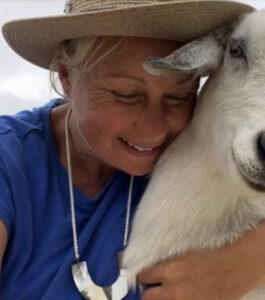Welcome to Podcast Episode 3 of The Greenstead Life, the podcast where we wander through garden paths, gather knowledge leaf by leaf, and reconnect with what really matters — slow living, wild beauty, and food straight from the land. It’s also where we break the rules, reclaim our time, and begin to shape a life that feels more like our own. This is the art of living differently — not by walking away, but by quietly returning to what matters.
I’m Liv, and in today’s episode, I’ll be sharing something really special — our very own brand-new bush tucker garden design, freshly planted here on the Greenstead in Central Gippsland. We’ll walk you through each native edible we’ve chosen, how and where we’ve planted it, and what it offers — from the berries and leaves on your plate to the birds and bees it welcomes in. You’ll also hear fun facts and fascinating stats about each species, along with growing tips, recipe ideas, and some gentle guidance to help you create your own edible native garden wherever you are.
🌿 Quick Note Before We Begin: Please remember not to forage for edible native plants unless guided by a qualified expert. Many species look alike, and some can be harmful. Instead, always source your plants from reputable native nurseries — ideally Indigenous-owned — and help preserve the deep traditional knowledge woven into every seed and leaf.
We’ve planted this edible native garden as a flowing, circular design around our natural water feature — a living, breathing ecosystem that nourishes every species it touches. Just recently, we introduced these young seedlings to the soil, carefully selecting each position for microclimate, moisture, shelter, and light. Most are still establishing, their roots settling in as we prepare them for the seasons ahead. The soil here stays moist, enriched with natural mulch and framed by shade and sun pockets, creating an ideal setting for these future food plants to thrive.
Some of our more tender species — like lemon myrtle, aniseed myrtle, and ginger — have been tucked into warm, sheltered spots with protective layering to help them through their first winters. Others, like the lilly pillies, riberry, and blue tongue shrubs, now mark the edges of our garden paths and seating nooks, growing steadily toward their full size. In time, this carefully curated planting will form a soft edible hedge throughout the space, filled with fragrant leaves, colourful berries, and visiting bees and butterflies.
As you listen, we invite you to think about how these Australian native bush tucker plants might work in your own space. Whether it’s a few midgem berries in a pot, some pigface tumbling from a sunny basket, or a fragrant lemon myrtle anchoring your edible garden, there’s a native plant to suit every setting. You don’t need a sprawling acreage — just a little sun, some care, and a willingness to experiment.
So pop on your garden boots, pour a warm cuppa, and let’s walk slowly, plant by plant, through this delicious native lineup of edible Australian plants for backyard and balcony gardeners alike.
One of our centrepiece plantings is Syzygium australe ‘Express’, a glossy-leaved Lilly Pilly shrub that will grow up to three to five metres tall over the next five to seven years. Positioned along the ponds’ sun-drenched curves where morning light filters through the canopy, it’s already settling into rich soil and will likely offer its first flush of edible pink berries within three to four years — perfect for homemade jams or to enjoy fresh from the branch.
Nearby, we’ve nestled a soft-featured variety known as Syzygium ‘Cascade’, another beautiful Lilly Pilly, with cascading foliage and blushing pink new growth. It will grow up to three metres tall and two wide within six to eight years. Tucked near the sheltered seating nook with filtered sun and still air, it should begin to produce mauve berries within two to three years — a subtle delight for dessert garnishes or native syrups.
In a gentle dappled area under taller companions stands our young Acronychia imperforata, or Fraser Island Apple. This small tree will grow up to three to five metres in five to seven years, offering tart, citrus-scented fruit ideal for cordials or native vinaigrettes by year four or five. We protect frost sensitive young trees like these by wrapping them in breathable horticultural fleece during colder months, ensuring they stay warm without trapping moisture, while a generous layer of mulch around the base helps maintain steady soil temperatures and protect the roots. Like many bush foods, flavour can vary — and this fruit must be fully ripe before tasting, as unripe samples or excessive consumption can cause discomfort.
The beautifully scented Backhousia citriodora, or Lemon Myrtle, finds its home in the warmest arc of our planting near the waterline. It will grow up to six to eight metres over the next seven to ten years, and by year five, we expect to gently gather its fragrant leaves for tea blends, biscuits, and seasonal baking.
Its cousin, Backhousia anisata, or Aniseed Myrtle, has been tucked into a humid, sheltered pocket with good air circulation. This sweetly aromatic tree will grow up to six metres tall in around seven to nine years and should be ready for its first leaf harvest by year three or four — a beautiful flavour addition to both sweet and herbal creations.
Rising with elegance along the edge of our winding garden path is Syzygium luehmannii, commonly known as Riberry. It will grow up to ten metres over eight to ten years and may begin fruiting within three. Its deep red berries have a gentle clove-like tang and are perfect for chutneys, sauces, and native jams.
Among our understorey, we’ve tucked Zingiber officinale, or Edible Ginger, into a warm, well-drained corner. This lush herb will grow up to one metre and reach full maturity in under two years, with its first harvestable rhizomes arriving as early as twelve months — ideal for herbal tea, warming curries, or preserving in honey.
In a nearby shadier curve, we’ve placed Alpinia caerulea, the Native Redback Ginger, where lingering moisture suits it well. It will grow up to two to three metres tall in four to five years. Its edible blue fruits and tender shoots should arrive by year two or three, while its broad leaves are also useful for steaming and wrapping plant-based meals. Just remember — eat only the soft outer fruit, not the seeds, and avoid overconsumption.
Anchoring the back of the bush tucker pond garden, near larger trees, is the majestic Pleiogynium timoriense, or Burdekin Plum. This tree will grow up to fifteen metres in over ten years and may begin to fruit between years five and seven. Its dark, earthy plums are best ripened off the tree and are lovely in preserves or chutneys. Avoid eating unripe fruit, as it can be astringent and irritating to the mouth.
Spilling over the sunniest banks, Carpobrotus rossii, or Pigface, is a hardy native groundcover that will reach full spread in just twelve to eighteen months. Its juicy magenta fruit and salty-sweet leaves appear early and offer an abundance of snack potential, though the leaves are best enjoyed in moderation as they may have a mild laxative effect if consumed in large quantities.
Melastoma affine, affectionately known as Blue Tongue, has been planted near a sun-warmed spot where native birds and bees visit for water. This playful shrub will grow up to 2.5 metres in three to four years and begin fruiting in its second year, producing juicy purple berries that stain the tongue and delight the senses.
In the drier corner of the garden, Carissa ‘Desert Star’ is a compact shrub that will grow up to one metre in about three to four years. It’s already setting down roots and will offer fragrant white star-shaped flowers and small red fruits for sweet preserves or jelly by the second or third year.
Close by, a rare white-flowered form of Blue Tongue, Melastoma affine ‘Alba’, has been positioned in a cooler shaded path where it will grow up to 2.5 metres in three to four years. Its softly sweet berries should start to appear within two to three years, bringing elegance and gentle contrast.
Between sandstone pavers and mossy rocks, Austromyrtus dulcis — or Midgem Berry — is making itself at home. This dainty groundcover will grow up to one metre in around three years, with its first crop of sweet, speckled berries expected by the second. They’re lovely sprinkled on breakfast or used in desserts, though like all berries, moderation is key to avoid digestive upset.
Along sun-drenched paths, Austromyrtus ‘Copper Tops’ is thriving with its warm bronze tips. It will grow up to one metre in three years and should begin bearing its small bird-loved berries in year two or three, adding contrast and colour to the edible hedge.
Not far from our bench seat, Austromyrtus ‘Blush’ displays its rich, burgundy-tinged foliage and will grow up to 1.5 metres within three to four years. It should begin producing its soft-flavoured berries by year three — ideal for seasonal jams or as a delicate fresh snack with native mint.
Winding through the salt-kissed, wind-touched pockets of our garden is Sesuvium portulacastrum, known as Sea Purslane. This coastal spreader will establish itself within one year, offering crisp, tangy edible leaves that work beautifully in salads or as garnish — one of the first to flourish in this edible native landscape.
In a shadier, serene nook sits Randia fitzalanii, the Native Gardenia. A slow-growing tree that will rise up to five metres over eight to ten years, it’s expected to flower and fruit between year five and six, offering fragrant blossoms and gentle yellow fruit for infusions or scent.
Framing the curves of our inner edible hedge is Acmena smithii ‘Minor’, a compact shrub that will grow up to 2.5 metres in four to five years. Its crisp, tart pink berries should appear around year three — a refreshing ingredient for chutney or frozen native desserts.
And finally, trailing through the mulch and gaps between our larger plantings is Tetragonia tetragonioides, known as Warrigal Greens. This fast-growing native spinach will fill out in just four to six months, offering some of the earliest leafy harvests. Rich in iron, it’s a hardy favourite for pies and curries — but always cook it before eating to neutralise the oxalates naturally present in its leaves.
Imagine creating your own vibrant nature pond haven right in your garden, just like we’ve done at the Greenstead. Picture a peaceful water space surrounded by abundant edible native plants, where small birds flit playfully over the calm surface, darting among branches and perching on shrubs, filling your outdoor sanctuary with joyful calls and fluttering wings — a daily reminder of nature’s delicate rhythms. Above, the wide-open skies reflect beautifully on the water, while a gently turning windmill by the edge adds a soothing, timeless rhythm that calms the soul. You can encourage local wildlife too — by thoughtfully providing safe, natural shelters with sun-warmed rocks, hollow logs, and shaded nooks, you invite curious Blue Tongue lizards to find refuge in your garden. And by creating clean, shaded, well-vegetated spots, you help support endangered frogs that rely on these habitats. As evening falls, imagine your own pond coming alive with the gentle chorus of night-time creatures, filling your garden with the magic of biodiversity. This is the kind of flourishing, balanced ecosystem you can nurture — where every creature, from birds to reptiles to frogs, finds its place and adds to the rich life of your green sanctuary.
As we close today’s episode, a gentle reminder that even in the most bountiful garden, safety always comes first. Many native edibles have non-edible lookalikes, so it’s vital to ensure you’ve identified each plant correctly — ideally sourcing young stock from trusted native nurseries and, where possible, those owned or guided by Indigenous Australians with deep knowledge of country and species.
Once growing, treat your garden as you would any other food-producing space. Always wash fruits, berries, and leaves thoroughly before using them, particularly in shared or open spaces where curious wildlife may have passed through. And while many of these plants are safe for children and pets, it’s wise to keep a close eye during first introductions — especially with species like Carissa ‘Desert Star’ or Sea Purslane, whose flavours or textures may not be to everyone’s liking and can be overgrazed by animals.
It’s also important to know that even edible native plants, like any food, can trigger allergic reactions. When trying something new — especially aromatic leaves like Lemon Myrtle or Aniseed Myrtle — start small and observe how your body responds. In nurturing these plants, we nurture ourselves, and thoughtful, informed care helps ensure that this beautiful harvest continues to nourish us for seasons to come.
Would you like to come and see our brand new bush tucker garden first hand? Come visit us. You can book your stay at Banjos Cabin Gippsland or Gumnut Cottage Gippsland at greensteading.com.au and wander these plant-filled paths yourself. Smell the leaves. Learn about eco-friendly edible garden design. Feel the magic.
And if you’re inspired to start your own edible native patch — do it! Start with just one or two, learn their needs, and build from there. Your local bees, birds, and bellies will thank you.
We will look forward to seeing you for episode four, where we will explore the concept of opening your own eco stay and how this can set you on your path to financial freedom.



